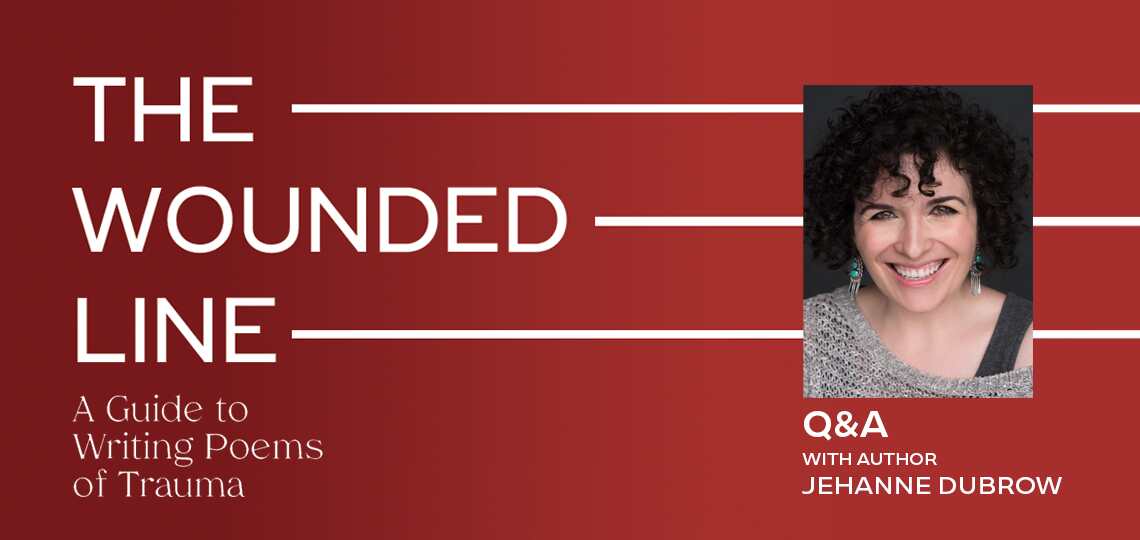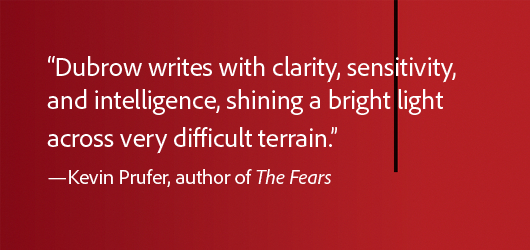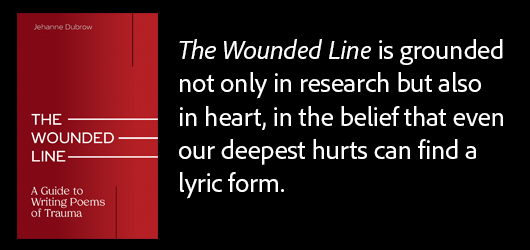Transforming Trauma into Poetry: A Conversation with Jehanne Dubrow

Executive Editor Matt Sutherland Interviews Jehanne Dubrow, Author of The Wounded Line: A Guide to Writing Poems of Trauma
Funny thing about poetry: it’s always welcome, even in the darkest of times.
Poet, essayist, and educator Jehanne Dubrow spent her career attempting to understand how poets are able to create compelling works of art from hurt, grief, and loss, putting these lessons into practice in her own writing and developing practical strategies to help other poets who wish to explore difficult, painful narratives.
With a student’s inquisitiveness, Foreword’s Matt Sutherland reached out to Jehanne with a list of questions about her new craft book, The Wounded Line: A Guide to Writing Poems of Trauma.
At this stage in your esteemed writing and teaching career—ten collections of poetry, three books of nonfiction, and many years lecturing and writing about how writers represent atrocity—what compelled you to write The Wounded Line?
In many ways, I’ve been writing this book in my head for the last twenty years. It comes out of my training in Holocaust and Genocide Studies, war literature, and Trauma Studies. As I explain in the book, I have noticed that my students—both at the undergraduate and graduate levels—seem particularly compelled to write about trauma. And I have seen that many of my students also struggle to make the leap from reading great works of literature that engage with trauma to writing their own poems about the traumatic. So, I wrote The Wounded Line as a way of articulating the specific, craft-based techniques that any poet can use when trying to engage with intensely painful subject matter. Each approach is based on my reading and my study of skillfully made poems (as well as texts from other genres).
Cathy Caruth writes that trauma “is always the story of a wound that cries out.” Let’s talk about the word, the experience, the meaning of trauma. Are there certain qualifications needed to write about trauma? What must trauma poetry always do?
I’m so glad you mention Cathy Caruth; her ideas about the nature of trauma have been essential to so many writers, scholars, and teachers. But it’s also important that you point to Caruth, because I think a poet’s primary qualification for writing about trauma is engagement with research, with reading the writers and thinkers who have come before. I hope you’ll forgive me for quoting a moment from the introduction of my book:
“One of the greatest difficulties poets encounter when first attempting to write about trauma is the certainty that the pathos of the subject matter alone is enough to create a powerful work of art. They may believe that a personal connection to the topic guarantees they will write authentic, moving poems. As a result, people often rely on the horror of the narrative to do the intellectual and emotional work of the text.”
I believe the antidote to this difficulty is simple. It’s important that we study the literary conversation we wish to join. What have other poets written about the kind of trauma we hope to examine? What are some of the essential themes, the persistent questions, the images and tropes that keep recurring across generations of writers? Poems that engage effectively with trauma show self-awareness and an understanding of the field. And I think they must have not only a heart but also a mind.
What is it about trauma that makes it so difficult to write about? And, why is it important that writers and poets continue the work?
In my book, I list a series of difficulties. Most of these difficulties were initially voiced through Holocaust Studies, but I believe all are applicable to writing about other forms of trauma too. First, there’s the general difficulty of representing past events. Next, there’s the fact that pain has a distorting effect on memory, perception, and the intellect; it’s crucial that poems of trauma represent such distortions. Then, there’s the issue of how trauma seems to break the continuum between past and present, so that the past-self and the present-self feel disconnected from one another, almost as if two entirely separate people exist. A fourth problem has to do with the ways in which pre-traumatic approaches to writing may no longer feel effective or even relevant after the trauma has occurred. And, finally, there’s the immense challenge of representing both the pain itself and the erasure of that pain (so many traumas are followed by efforts to diminish, silence, or altogether erase their occurrence).
Why continue this work despite its difficulties? Well, I suppose the answer goes back to what Cathy Carruth observes, that trauma “is always the story of a wound that cries out.” When we hear something crying, don’t we want to find the source of that weeping? Don’t we want to help it or soothe it? The poem gives voice to the wound. And sometimes finding that voice is the only way to recover.
In twenty short chapters, you offer readers “techniques for writing poems that represent the experience of being inside the traumatized mind,” in addition to “rhetorical strategies that poets can use to make arguments about the nature of trauma itself.” How did this book come together? Can you talk about your research, decisions you made along the way, and what it was like for you to spend so much time entrenched in the subject of trauma?
Because I’ve taught this subject for the past two decades, much of the task of creating The Wounded Line came down to figuring out how to translate the essential concepts of my teaching onto the page. The most enjoyable part of constructing the book was finding poems to illustrate these practical techniques and rhetorical strategies. I tried to include a lot of poems that are not yet in full-length collections so that readers would not only learn some novel approaches to engaging with trauma but would also discover some wonderful new poets. It was exciting to develop writing prompts too, exercises that speak directly to the poems in the book.
I’ve been entrenched in the subject of trauma my entire academic life. At this point, I know how to pace myself when I’m dealing with intensely painful literature. What moves me about well-crafted poems that explore trauma is that they make palpable the relationship between form and content. A poem that effectively represents trauma argues—in every line, in every phrase, in every image—that certain kinds of stories demand certain kinds of storytelling. Writing about trauma is very hard. When it’s done well, that’s a testament to the author’s skill, training, intelligence, and creativity.
Each chapter ends with a series of prompts—Write Your Way In—in which you offer detailed instructions to get the pen moving. As an example, here’s one from chapter 8, Surrealisms: “Write a self-portrait in which the speaker is depicted as a mythological creature. How does this character respond to trauma? How does this character shoulder the burdens of that pain?” How do you intend for readers/poets to engage with the book and these prompts?
I hope readers are inspired! I hope the prompts make readers want to write their own poems. The book is intended to be welcoming, not to scare readers away but to offer them helpful approaches to a difficult undertaking.
Not everyone has experienced trauma, of course. Can poets write about traumas that they haven’t faced directly?
I think so. The work is always fraught and delicate, whether you’re writing about your own trauma or that experienced by an ancestor or even the pain of a stranger. In all cases, I believe that doing research (including archival research, interviews, research trips, etc.) and reading extensively across genres and disciplines can be essential to the process. As I said earlier, it’s not enough just to hope that “the pathos of the subject matter alone is enough to create a powerful work of art.” It’s a big responsibility to write about pain, both one’s own pain and the pain of other people. The task demands intellectual rigor, emotional honesty, and a dedication to literary craft.
Please talk about the difficulty of critiquing trauma poetry, in the sense that a poet might be too close to the topic and unable to handle a close reading of their work? As well as the cases where the poet is disappointed in creative writing workshops, where the muted “I’m so sorry this happened to you” responses offer her little valuable feedback.
Offering feedback about any poem is very tricky business. But when you add trauma to the mix, it becomes an even more delicate process. In creative writing workshops—undergraduate, graduate, and even community-based classes—it can be challenging to gauge what level of critique the poet is ready to receive. Is the writer prepared to hear that revisions are still necessary? Or is the trauma too fresh for the poet to detach emotionally from the draft?
And sometimes, the writer is ready to receive thoughtful, detailed feedback, while the rest of the class is uncomfortable providing nuanced, rigorous responses to the text. This can leave the writer frustrated and angry.
An academic workshop isn’t meant to be a therapeutic space. Therefore, poets should only bring in drafts that they’re excited to revise into works of art. And the rest of the class needs to enter the conversation with the belief that critique—serious, demanding, sensitive critique—is the highest compliment you can pay to a poem.
What advice do you have for readers of poetry? How do you, personally, read a poem?
When I’m leading students through a close reading of a poem, I begin by asking them to “summarize the plot of a poem in a single sentence.” This is my way of determining how accessible or inaccessible they find the poem’s narrative (however slight that story might be). Then, we examine a poem’s shape on the page, its line lengths and line breaks, its use of stanzas, its sentence structure, and its handling of imagery and figurative devices. Slowly, from there, we track the argument that the poem is making. Who is speaking? Who is the audience? How do form and content mirror each other? Only once we’ve done a close reading of the whole text do I ask students: What does this all mean?
You offer many dozens of poems as examples of different techniques or approaches used by accomplished poets to express trauma. Are we allowed to ask you to name a few of the contemporary poetry collections you recommend for their approaches to trauma?
I love recommending poetry collections! Here are just a few suggestions. For the reader who wishes to explore violence and loss within a family, I recommend Beth Bachmann’s Temper. For someone struggling to write about a devastating loss, such as the death of a loved one by suicide, I suggest Matt Rasmussen’s Black Aperture. Hadara Bar-Nadav’s The Animal Is Chemical is a terrific study of the long-term effects of intergenerational trauma, and Kikki Petrosino’s White Blood considers ancestral memory (both use research in powerful, engaging ways). And if you’re interested in using a traditional form—such as the sonnet—to write about trauma, then Marilyn Nelson’s A Wreath for Emmett Till would be a great place to begin.
What’s next for you and your talented pen?
Thank you so much for that question. I’m currently working on a new collection of poems, The Brief Temple Taken Down, which looks at the relationship between the health of the body and the health of the body politic. I’m also putting the finishing touches on a book-length essay, Frivolity: A Defense. And I’ve recently started work on a collection of essays, Red Monsters, which is about the intimate relationship we develop with works of art that we love. How is it that our identities can become so enmeshed with a favorite book or a cherished piece of music? How do these things become so much a part of our lives? How do they teach us so much about the world and about ourselves?
Matt Sutherland



